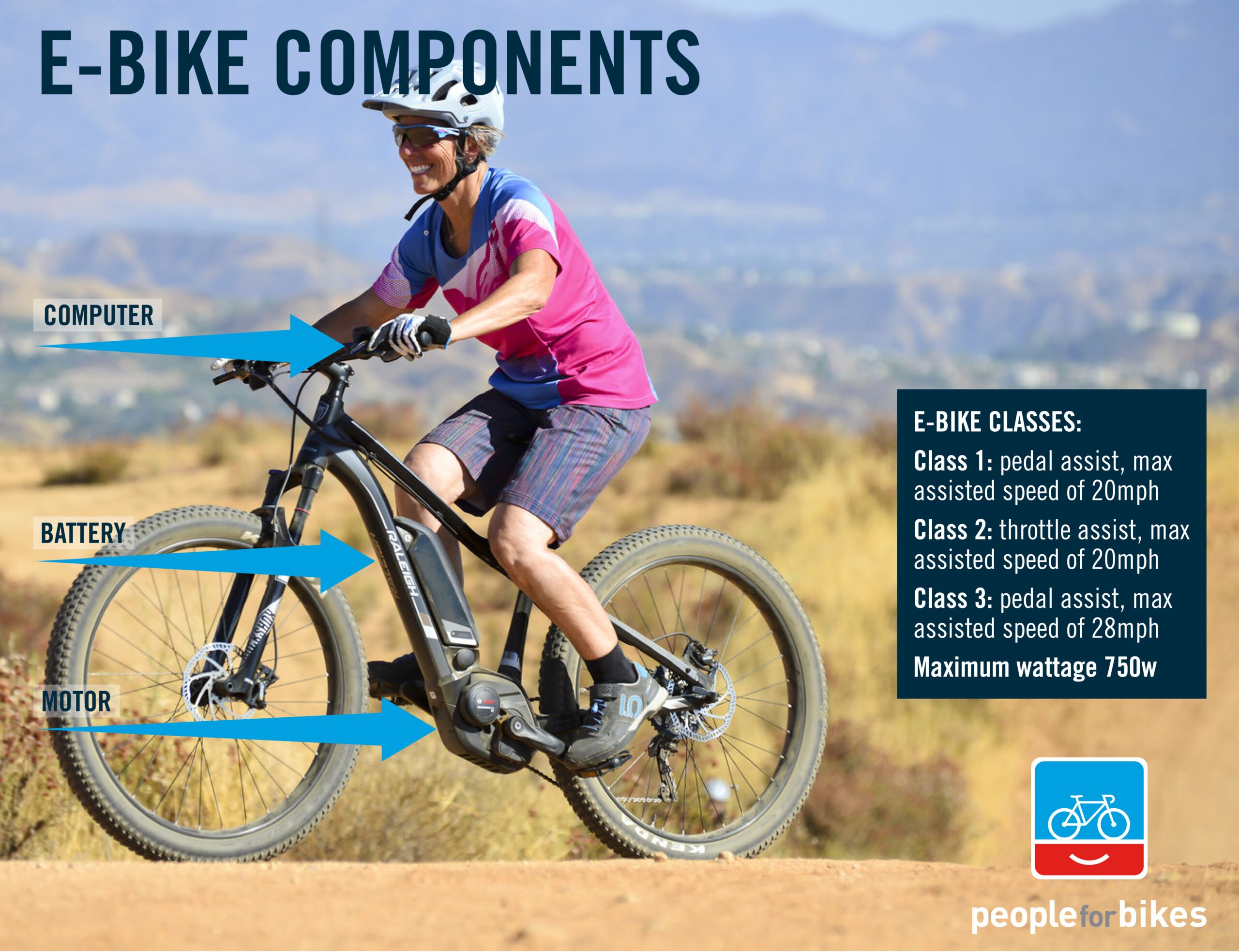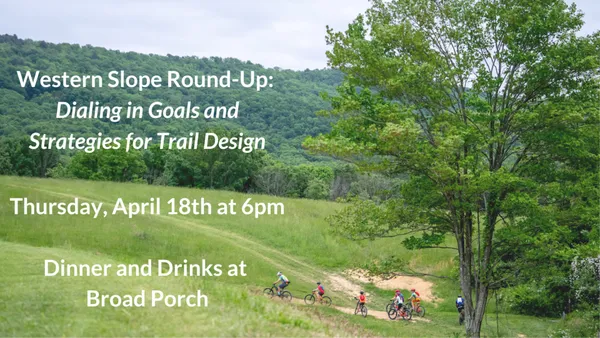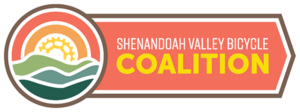Discussions around Electric Mountain Bikes (eMTBs) often trigger an instinctual and emotional reaction among those of us who recreate via natural surface trails on our public and private lands. The Shenandoah Valley Bicycle Coalition recognizes and acknowledges the wide range of strong opinions regarding eMTBs along with associated cultural challenges. We understand land access concerns and appreciate the historically sensitive nature of bicycle access to natural surface trails. We are weighing into the eMTB discussion with an emphasis on welcoming and including a wider range of people to our magical trails.
Starting last year, our marquee trail system at Massanutten’s Western Slope officially opened to eMTBs. (For those who don’t know, the Western Slope trails is a unique partnership between the Coalition and the property owner, Massanutten Resort where visitors can obtain a trail pass via the Coalition with all proceeds going back to the Bicycle Coalition). While we have been slow in rolling out signs and announcements, eMTBs are already using the Western Slope trails. We expect their use to only increase and strive to clarify where we stand and explain our full support of eMTBs on our Massanutten Western Slope Trail System.
At this time we have not formulated a position regarding eMTB use on National Forest trails and look forward to further engaging our members, land managers, and the broader community of visitors on the issue. We view the Western Slope as our trails laboratory and a perfect place to introduce and monitor eMTB access.
What Exactly is Allowed on the Western Slope Trails?
Only Class 1 eMTBs are allowed on the Massanutten Western Slope Trails. This class of eMTB only provides assistance while the rider is pedaling and ceases to provide assistance when the bicycle reaches the speed of 20 miles per hour. The Coalition believes this class of eMTB can be managed in a sustainable way for both the environment and other trail users on the Massanutten Western Slope Trails. Class 1 bikes account for the vast majority of eMTBs sold by the major bicycle manufacturers.
Why are we in support?
eMTB access to non-motorized trails that are open to bikes presents both opportunity and challenge. If managed effectively, eMTBs may increase ridership and stewardship of trails, along with other benefits. No management, poor management and/or misinformation, however, have the potential to jeopardize current and future access to a range of trails. Access fears are not a reality for the Massanutten Western Slope trails where the introduction and acceptance of eMTBs won’t jeopardize our access in any way in the present or future. In fact, the decision to allow eMTBs was made in tandem with the land manager, Massanutten Resort who is fully supportive of the change.
We have a unique opportunity with the Western Slope Trails to push the limits and boundaries of our trail building and optimize trails for bicycles. Trails in and around the Shenandoah Valley are almost exclusively on public land, specifically in the George Washington National Forest. Our special partnership with Massanutten Resort allows us rare access to a sizable trail system on private property. As a result, we are able to execute trail projects quicker while optimizing trails for bicycles with new and innovative techniques. Given the unique nature of this “Trails Lab” setting, we believe it is the perfect location to see how eMTBs work for our region.
Core Values
Here at the Bicycle Coalition, we always look back to our core values when tackling emerging issues as we navigate uncharted waters. These core principles help guide our decision making and ensure we are always making the best decision for the broader community, our members, and the long-term goals of our mission and organization. Our core values include:
Joy: We believe bicycles bring joy to people and that the world would be a better place if more people rode bikes. Period. We support more people on bikes just about wherever and wherever we can. We are always on guard against decisions that might impact and decrease the joy of others. With that said, you will need to look elsewhere for regulation and management of Strava KOMs and the like as we do not see such matters as worthy opponents to the greater good.
Inclusion: Does our position make Bicycling more inclusive? Especially given our steep and challenging terrain, eMTBs have the potential to grow many new riders and help those riders who have physical limitations that may prevent them from enjoying our magnificent trails. We think everyone can get behind the desire to bring all types of people into our special natural places in a respectful and compatible manner. We believe the limitations on Class 1 eMTBs increase access, make our trail system more inclusive while respecting our responsibility to be good stewards. After all, don’t more people deserve an opportunity to experience the joy and magic of tires on dirt?
Stewardship: Every decision we make must ensure we are looking out for future generations. Access is a big issue here. What good is all of this if we lose access to our favorite trails? In the case of the Massanutten Western Slope Trails, losing access is not even a remote consequence of allowing eMTBs onto our beloved trail system. In fact, increased use of the trail system through rider diversification provides a larger voice should land-use interests change.
Thank you for your interest in this topic and we welcome your input, thoughts, and opinions. Feel free to contact us at any point via ().
With much love,
The Shenandoah Valley Bicycle Coalition
Classes of eBikes
- CLASS 1: This is the class of eMTBs allowed on the Massanutten Western Slope Trails. A “class 1 electric bicycle,” or “low-speed pedal-assisted electric bicycle,” is a bicycle equipped with a motor that provides assistance only when the rider is pedaling, and that ceases to provide assistance when the bicycle reaches the speed of 20 miles per hour.
- CLASS 2: This class of eMTB is NOT allowed on the Massanutten Western Slope Trails. A “class 2 electric bicycle,” or “low-speed throttle-assisted electric bicycle,” is a bicycle equipped with a motor that may be used exclusively to propel the bicycle, and that is not capable of providing assistance when the bicycle reaches the speed of 20 miles per hour.
- CLASS 3: This class of eMTB is NOT allowed on the Massanutten Western Slope Trails. A “class 3 electric bicycle,” or “speed pedal-assisted electric bicycle,” is a bicycle equipped with a motor that provides assistance only when the rider is pedaling, and that ceases to provide assistance when the bicycle reaches the speed of 28 miles per hour and equipped with a speedometer.
How eMTBs are Currently Managed?
Currently, eMTBs are not defined or dealt with consistently across land management agencies. eMTB access to trails and infrastructure depends on the authority with jurisdiction over the land.
U.S. Forest Service and Bureau of Land Management (BLM) regulations categorize eMTBs as a “motorized” use. Therefore, eMTBs are only permitted where motorized vehicles are allowed. Some state and local authorities manage eMTBs similarly to federal agency regulations. however, other agencies have decided to open non-motorized trails to eMTB use. Several state parks, county open space organizations and municipalities treat electric bicycles identically to non-motorized bicycles or have designated specific areas that are open to eBikes. Many government entities have not yet considered the issue or have no policy regarding eMTB use at this time.
What About the National Forest?
eMTBs are not allowed on non-motorized trails because the current Forest Service regulations categorize them as “motorized.” At this time, the Coalition is not actively advocating for eMTBs on any shared-use trails in the National Forest. We ask eMTB riders to respect closed trails and only ride where it is legal. We encourage riders to explore open Forest roads as well as ATV/OHV areas on eMTBs if interested.
Where Else can I Legally Ride an E-MTB in the area?
- Any National Forest roads that are open to motor vehicles
- Rocky Run and Second Mountain ATV/OHV area
- Peters Mill Run/Taskers Gap OHV System

FAQs on eMTBs
WHAT ARE CLASS 1 eMTBs?
» Class 1 eMTBs are like traditional bicycles with fully operable pedals, but with a small motor that will only engage if the rider is pedaling.
» E-bikes are emissions-free, low impact, and operate silently.
» E-bikes are not motorized vehicles like gas-powered vehicles.
» E-bikes are as safe, stable, and sturdy as traditional bicycles and move at bike-like speeds. Many models offer the same qualities of suspension and responsiveness that traditional mountain bikes provide.
WHAT PHYSICAL IMPACTS DO CLASS 1 eMTBs HAVE?
» Class 1 eMTBs have been shown to have similar impacts to natural surface trails as traditional mountain bikes. Link to study.
CLASS 1 eMTBs CAN:
» Allow increased access to the outdoors for riders of varying skill levels.
» Help people of different skill levels ride together.
» Address the challenges of local air quality, climate change, obesity, and lack of physical activity.
» Allow people to bicycle when they would not otherwise due to physical fitness, age, disability, or inconvenience.
» Reduce greenhouse gas emissions and fossil fuel consumption, improve air quality, and support alternative modes of transportation.
FOR PARKS, CLASS 1 eMTBs CAN:
» Meet many stated park goals or mandates.
» Bring innovation to a park’s fleet and support alternative modes of staff transportation.
» Carry up to 400 lbs. of cargo and be equipped with built-in hauling features, specialty baskets, versatile racks, carrying bags, and other accessories to accomplish many maintenance and enforcement needs.
» Provide a new option for staff who want to use a bicycle but would otherwise not because of physical limitations.
ARE CLASS 1 eMTBs SAFE?
» E-bikes offer the pleasure and freedom of bicycling with no known compromise in consumer safety.
» The average Class 1 eMTB rider is no faster than the fastest mountain biker.
» The maximum power of Class 1 eMTBs does not exceed the maximum power output of human capability.
» E-bikes, in fact, increase road safety with more cyclists on the road and reduce demand for parking spaces




